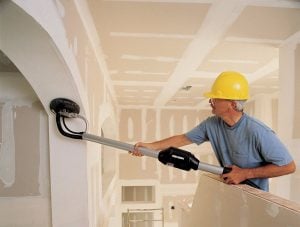Unfortunately, there is no way to be completely dust free while sanding drywall, but if you follow the steps below you will certainly reduce the amount of dust that’ll accumulate or be introduced to other parts of the house.
Create a Barrier to Confine Drywall Dust
Most would say this is common sense, but you may be amazed to know how many people who sand drywall don’t take the time to create a barrier. This tip is relatively simple, but let’s make this very clear as it will not eliminate drywall dust all-together.
You can pick up a roll of sheet plastic at your local hardware store which you can then tape the plastic on walls, ceilings, floors, and other areas creating a barrier. This is where you literally separate the room you’re working in from the rest of the house which will in essence confine the drywall dust to one location.
In theory this will work, but only if you never go from one area or the other and if no holes are accidently introduced to the plastic. While minimizing dust, you’ll still be surprised how much get from one area to the other.
Pull Out the Drywall Dust with Negative Pressure
Negative pressure will help pull the drywall dust out of the room in which you’re working in. This is very easy to do and is used in conjunction with the step above. Much of the drywall dust that is more reminiscent of a cloud is pulled out of the room using a box fan with the air flow just outside of the room. This helps creates a vacuum effect which will help pull the drywall dust out of the room in which you’re working.
Use a Low-Dust Drywall Joint Compound
A low-dust drywall compound is much heavier than your typical joint compound. The heavier compound allows much of the drywall dust to fall to the ground due to the weight whereas the much lighter joint compound floats within the air creating the cloud effect.
Drywall Sanding Vacuum Hooked to a Shop Vac
Probably the easiest way to minimize drywall dust is to use a drywall sander which acts like a vacuum with the right attachment. A drywall sanding vac is literally a hose that attaches to a specialized sander which is made precisely for sanding drywall.
One end of the drywall sanding vac (hose) affixes to the sander while the other side of the hose gets placed in a bucket of water. When the drywall dust and other sanding particles enter the bucket it gets trapped in the water which acts like a vacuum.
In theory, this is the best way to minimize drywall dust when sanding, but it may limit how practical sanding is on drywall. The suction effect from the vacuum makes it difficult to move the sander on the drywall which causes more of a physical demand on yourself.
You can check out the top rated drywall vacuum sander with hose from Amazon and get free shipping through the exclusive link below.





